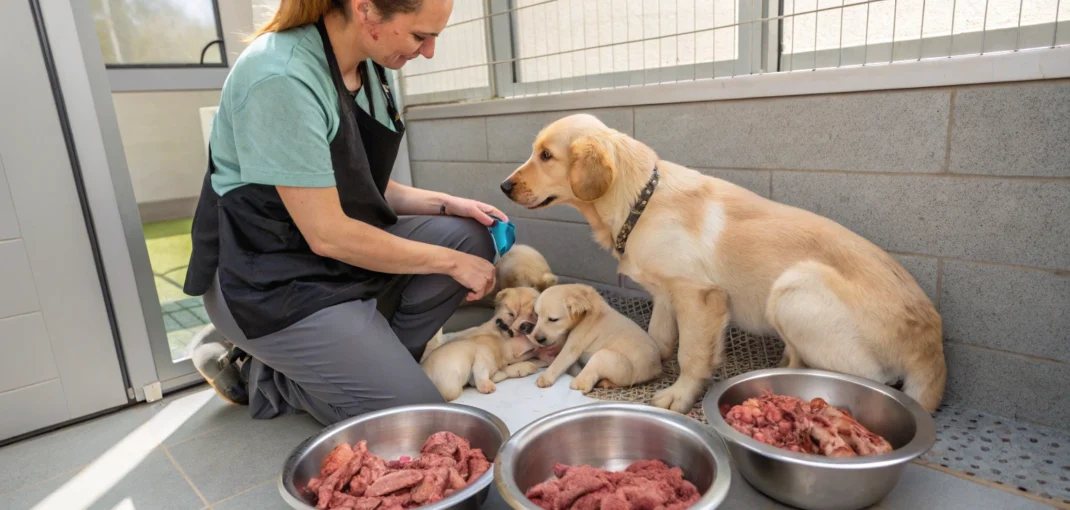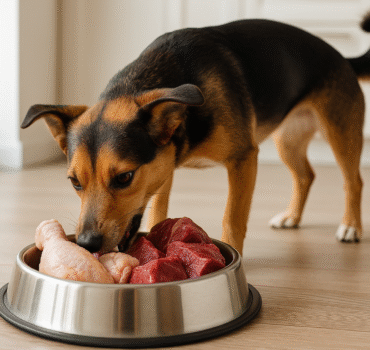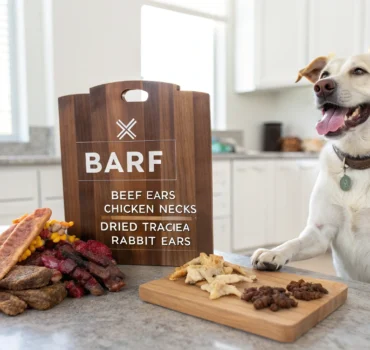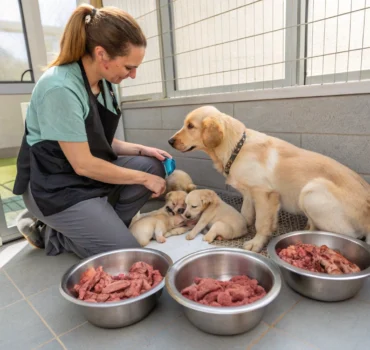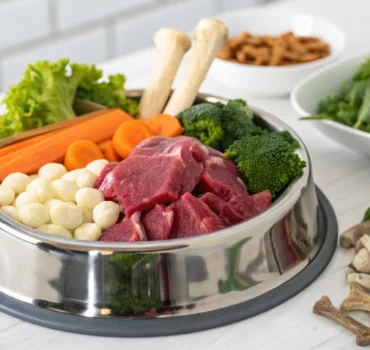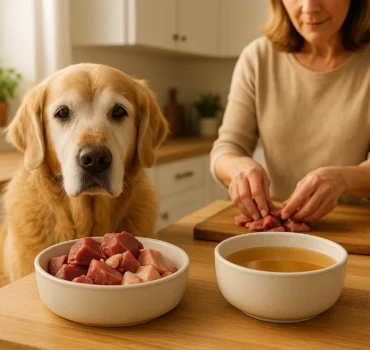The Complete Guide to Healthier Litters and Stronger Puppies
If you’re a dog breeder, you already know that what you feed your dogs directly impacts the health of their puppies. But have you considered switching to a raw food diet for breeders?
More and more professional breeders are ditching kibble and choosing raw feeding. They’re reporting healthier pregnancies, easier births, stronger puppies, and fewer vet bills. Some even say it’s transformed their entire breeding program.
This isn’t just a trend. It’s a return to how dogs ate for thousands of years before processed food existed. And for breeders who want to produce the healthiest puppies possible, it might be the missing piece of the puzzle.
In this guide, you’ll learn why raw feeding matters for breeding dogs, how to do it safely, and what results you can expect when you make the switch.
Why Breeders Are Switching to Raw Food
Traditional dog breeders have relied on kibble for decades. It’s convenient, it’s shelf-stable, and it’s what everyone else uses. So why change?
The answer is simple: results.
Breeders who switch to a raw food diet for breeders report noticeable improvements across the board. Their breeding females have easier pregnancies and produce more milk. Their puppies are born stronger and grow faster. Health problems that used to be common in their lines start disappearing.
Think about it from a biological perspective. Wild dogs and wolves don’t eat processed food. They hunt, they eat raw meat and bones, and they reproduce successfully. Their puppies survive and thrive without any commercial dog food.
When you feed your breeding dogs a diet closer to what nature intended, their bodies work better. It’s not magic. It’s just giving them the nutrition they were designed to use.
Many breeders also notice financial benefits. Yes, raw food can cost more upfront. But when you factor in fewer vet visits, healthier litters, and puppies that go home in better condition, the investment pays off.
Nutritional Benefits for Breeding Dogs
Breeding dogs have different nutritional needs than regular pets. Pregnant and nursing females need extra calories, protein, and specific nutrients to support their puppies. Stud dogs need optimal health to maintain fertility.
A raw food diet for breeders provides several key advantages:
Higher Bioavailability: Raw food contains enzymes and nutrients in their natural form. Your dogs can absorb and use these nutrients more efficiently than the synthetic vitamins added to kibble.
Better Protein Quality: Raw meat provides complete amino acid profiles that support muscle development, milk production, and overall health. This is especially important for pregnant and nursing females.
Natural Calcium and Phosphorus: Raw meaty bones provide these minerals in the perfect ratio for bone development. This matters tremendously for growing puppies and lactating mothers.
Omega-3 Fatty Acids: Raw fish and certain meats provide essential fatty acids that support brain development in puppies and reproductive health in adults.
Digestive Health: Raw food includes natural probiotics and enzymes that support gut health. A healthy gut means better nutrient absorption and a stronger immune system.
These benefits aren’t just theoretical. Breeders consistently report that their dogs look better, act healthier, and produce superior puppies on raw diets.
How Raw Feeding Improves Breeding Outcomes
Let’s get specific about what changes when you implement a raw food diet for breeders in your program.
Fertility Improvements: Both males and females often show improved fertility on raw diets. Stud dogs maintain better sperm quality. Females cycle more regularly and conceive more easily.
Healthier Pregnancies: Pregnant females on raw diets typically maintain better body condition throughout pregnancy. They’re less likely to experience complications and often have easier deliveries.
Stronger Puppies at Birth: Puppies born to raw-fed mothers tend to be more vigorous at birth. They start nursing faster and gain weight more consistently in those critical first days.
Better Milk Production: Nursing mothers on raw diets usually produce more milk and maintain their milk supply longer. This means healthier, faster-growing puppies.
Faster Puppy Development: Puppies weaned onto raw food often develop faster than kibble-fed puppies. Their teeth come in cleaner, their coats shine earlier, and they hit developmental milestones on schedule or ahead of it.
Fewer Health Issues: Many breeders report dramatic reductions in common puppy problems like loose stools, skin issues, and slow growth when they switch to raw feeding.
These improvements can set your breeding program apart and give your puppies the best possible start in life.
Creating a Raw Feeding Plan for Your Breeding Program
Starting a raw food diet for breeders doesn’t have to be complicated. Here’s how to build a practical feeding plan:
Start with Quality Ingredients: Source human-grade meat when possible. Look for a variety of protein sources including chicken, beef, lamb, fish, and organ meats. Don’t forget raw meaty bones for calcium.
Follow the 80/10/10 Rule: A basic raw diet consists of 80% muscle meat, 10% edible bone, and 10% organ meat (with half of that being liver). This provides balanced nutrition for most dogs.
Adjust for Breeding Status: Pregnant females need about 25-50% more food in the last few weeks of pregnancy. Nursing mothers may need 2-4 times their normal amount depending on litter size.
Add Variety: Rotate between different protein sources throughout the week. This ensures your dogs get a full spectrum of nutrients and prevents food sensitivities.
Include Some Vegetation: While dogs are primarily carnivores, adding small amounts of pureed vegetables or fruits can provide additional nutrients and fiber.
Supplement Wisely: Most raw-fed dogs don’t need many supplements, but breeding dogs may benefit from additional omega-3s, vitamin E, and specific minerals during pregnancy and lactation.
Keep detailed records of what you feed and how your dogs respond. Every breeding program is different, and you’ll need to adjust based on your specific dogs and breeds.
Transitioning Your Breeding Dogs to Raw Food
Don’t switch your entire kennel overnight. A gradual transition prevents digestive upset and gives you time to learn what works.
Week 1-2: Start with one raw meal per day, keeping other meals as kibble. Choose an easy-to-digest protein like chicken. Watch for any digestive issues.
Week 3-4: Increase to two raw meals per day if your dogs are handling it well. You can start introducing different proteins.
Week 5-6: Transition to fully raw if everything is going smoothly. Add in organ meats and a wider variety of ingredients.
Special Considerations: Don’t transition pregnant females in their last trimester. Wait until after they’ve weaned their puppies. For stud dogs, you can transition anytime.
Some dogs adapt to raw food immediately. Others need more time. Pay attention to stool quality, energy levels, and coat condition. These are your best indicators of how well the diet is working.
If you’re nervous about preparing raw food yourself, consider starting with a commercial raw food product. Many companies make complete and balanced raw diets that take the guesswork out of feeding.
Safety and Best Practices for Raw Feeding
A raw food diet for breeders requires attention to food safety. You’re handling raw meat, which means you need to follow proper protocols.
Storage: Keep raw food frozen until you’re ready to use it. Thaw in the refrigerator, not on the counter. Use thawed food within 2-3 days.
Cleanliness: Wash your hands, bowls, and surfaces thoroughly after handling raw food. Use separate cutting boards for dog food and human food.
Quality Control: Buy from reputable suppliers. Avoid meat that smells off or looks discolored. When in doubt, throw it out.
Puppy Safety: Puppies can start eating raw food as early as 3-4 weeks old. Start with ground meat and gradually introduce larger pieces as they grow.
Monitor Health: Work with a veterinarian who understands raw feeding. Regular health checks ensure your dogs are thriving on their new diet.
Bacterial Concerns: Healthy dogs handle bacteria in raw meat much better than humans do. Their stomach acid is highly acidic and kills most pathogens. Still, practice good hygiene to protect yourself and any immunocompromised people in your household.
Many breeders have fed raw for decades without any safety issues. Common sense and basic food safety practices are usually all you need.
Real Results from Breeders Who Made the Switch
The proof is in the puppies. Breeders across different breeds and countries report similar improvements when they adopt a raw food diet for breeders.
One breeder of German Shepherds reported that her puppies’ hip scores improved after switching to raw. Another breeder of Golden Retrievers said her females stopped having difficult deliveries once she changed their diet.
Small breed breeders often mention that their tiny puppies are stronger at birth and less likely to fade in the first week. Large breed breeders appreciate that their puppies grow at a steady, healthy rate without the growth spurts that can cause joint problems.
Show breeders love the coat quality that raw feeding produces. Puppies have shinier, healthier coats that catch judges’ eyes even at young ages.
Pet breeders find that their puppy buyers are impressed with the health and vigor of raw-fed puppies. Many continue raw feeding after taking their puppies home.
The common thread in all these stories is simple: healthier parents produce healthier puppies. When you optimize your breeding dogs’ nutrition, everything else improves.
Conclusion: Investing in Your Breeding Program’s Future
Switching to a raw food diet for breeders is one of the most impactful decisions you can make for your breeding program. It requires more effort than pouring kibble into a bowl, but the rewards are worth it.
Healthier breeding dogs, stronger puppies, fewer vet bills, and happier puppy buyers. These aren’t just nice bonuses. They’re the foundation of a successful, ethical breeding program.
You don’t have to make the switch alone. Join online communities of raw-feeding breeders. Read books by experts like Dr. Ian Billinghurst. Start small and learn as you go.
Ready to give your breeding dogs the nutrition they deserve? Visit Yummy Dog Food to explore high-quality food options that support healthy breeding programs. Your dogs and their puppies will thank you.
Frequently Asked Questions
How much does it cost to feed breeding dogs a raw diet?
Costs vary depending on where you source your meat and how many dogs you have. Many breeders spend $2-5 per day per dog, though this can be lower if you buy in bulk or find local suppliers. While it may cost more than cheap kibble, the reduction in vet bills and improvement in puppy health often makes it cost-effective overall.
Can I feed raw food to pregnant and nursing dogs safely?
Yes, and many breeders believe it’s actually better for pregnant and nursing females than kibble. The key is increasing food quantity as needed and ensuring the diet includes plenty of calcium from raw bones. If your female is already on raw food before breeding, continue through pregnancy and nursing. If she’s not, wait until after weaning to transition her.
What if my puppies’ new owners don’t want to continue raw feeding?
This is common and perfectly fine. Puppies raised on raw food can transition to kibble if their new owners prefer. Many breeders send puppies home with feeding instructions for both raw and kibble options. Some provide a starter supply of the food the puppy is eating and let the new owner decide whether to continue. The early nutrition advantage from raw feeding stays with the puppy even if they switch foods later.
